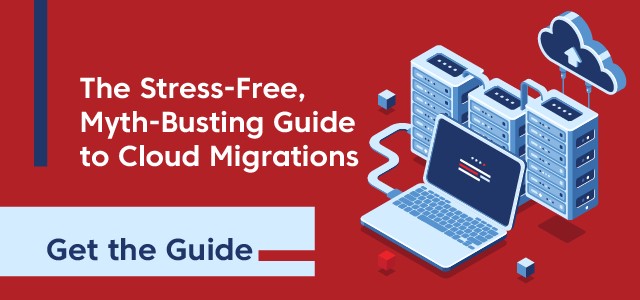Cloud migrations are like building a house.
All the materials to build a house are available from stores like Home Depot or Lowe’s. The expertise to put it all together is not.
A similar scenario unfolds when you sign up for a public cloud license from Amazon, Google or Microsoft (The Big 3). Doing so gives you the “raw materials” like CPU, RAM and storage. That’s not an up and running cloud environment. You’ll need to build, deploy and maintain your solution.
It doesn’t have to be this way.
You Don’t Have to DIY Home Building or Cloud Migration
You know how difficult it would be to construct a brand-new house, so you get a custom home builder and never seriously consider getting all the materials from Home Depot.
It’s a mentality you should maintain for the cloud migration
The Big 3 make it sound like you’ll be ready to roll after a few clicks. What gets obscured in their emails and webpages is the work behind planning, deploying, securing and managing your cloud environment.
Cloud migrations are a multi-step process, just like building a house
Choices you make will either lead to a scalable and secure environment or one that ultimately fails. The easiest path to success is to work with a cloud provider, like Zimcom. Our white-glove cloud migration services take care of everything for you, starting with the plan.
1. Your blueprint sets you up for success
Cloud migrations require planning as detailed as a blueprint for a home. Some of the questions you’re tasked with answering include:
- Should we be in a public or private cloud environment?
- Which applications, data and software do we want in the cloud?
- What happens if a mission-critical app isn’t cloud compatible?
- How long will the migration take?
- Which cybersecurity protections are right for our organization?
The full, exhaustive list runs through every scenario and stage of the migration
Many questions aren’t obvious unless you’ve received training and have hands-on experience, like: How will we ensure every user’s current permission level carries over to the cloud and they don’t gain access to data and settings they shouldn’t be able to view?
We Make Cloud Migration Easy
Here’s how
2. Storage – and your budget – end up just right
You may want a few more closets in your home, but too much cloud storage is a costly, common mistake for people who obtain licensing from the Big 3 on their own.
Have you ever tried to read documentation put out by Microsoft or Amazon?
If not, get ready to be perplexed. Potential clients bring us their bills filled with acronyms, IT jargon and ask us to decipher what they’re paying for. The bill is intentionally difficult to understand and easily leads to overspending on cloud resources.
Work with us and spend 30-50% less on the cloud
Our clients regularly save money by partnering with us instead of going with the Big 3. We typically help them spend 30-50% less on their cloud solution.
Plus, our billing model is straightforward: you pay for what you use.
3. Your environment is wired for safety
Bad wiring causes houses to burn. Cybersecurity breaches incinerate businesses.
Given the ever-growing threat of cyberwarfare and widespread prevalence of phishing attacks, you’d be forgiven for thinking cyber protections are automatic. That’s not how it works. You’re responsible for turning on cybersecurity features.
How to ensure cyber protections are up and running on Day 1
Our clients get secure by design cloud environments. We follow best practices and provide a solution that:
-
- Protects against ransomware
-
- Utilizes multi-factor authentication
-
- Leverages endpoint detections and response
-
- Thwarts DDoS attacks
-
- Encrypts data
4. Insurance is in place
A tested cloud backup solution is your insurance against cyberattacks, natural disasters, power surges or even just an employee who is too keen on hitting the “delete” button. It’s insurance for your business.
Why all our clients get 30 days of backups built into their solution
Flood insurance is mandated for especially vulnerable properties. In the cybersphere, every business is an “especially vulnerable property.” That’s why we include 30 days of backups for every single client. You can choose more, but not less coverage because we don’t want to see you lose everything if a worst-case scenario occurs.
5. You don’t fail inspections – aka compliance audits
Just like security isn’t automatic, neither is compliance. Because you’re left on your own to figure out cybersecurity, you could accidentally forget to turn on features required for compliance – resulting in fines.
Compliant by design
Our audit assessment processes and rigorous controls help our clients meet their compliance requirements including:
-
- SSAE SOC 1 and SOC 2
-
- ISO
-
- HIPAA/HITECH
-
- PCI
6. Delivered on time, without downtime
If there’s one place where our housing analogy doesn’t work, it’s here. Contractors are notorious for going over budget and taking longer than you anticipated. When it comes to the cloud, that’s what happens with DIY cloud migrations. It’s the experienced cloud experts who keep the project on track by quickly solving unexpected problems and minimizing downtime.
It’s faster than ever to migrate to the cloud
Gone are the days when you had to schedule a migration over a long weekend and users couldn’t access the system for hours or days. Cloud migrations are now easier for experts to execute and less disruptive to your business.
Get a Custom-Built Cloud Migration
For 20+ years, the team at Zimcom has delivered exceptional cloud services, hosting and customer service. Our solutions are scalable, secure, reliable and cost less than public cloud solutions from one of the Big 3 providers. When you get a custom-built cloud migration from Zimcom, our experts will plan, deploy, secure and manage your cloud environment.




